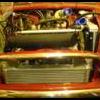6V Required
#1

Posted 24 September 2017 - 07:50 PM
I have a pair of 6 volt horns...what would be the best way of reducing a 12v feed down to 6v in order not to fry these? I see that holden sell 12v to 6v reducers for gauges that are in a similar situation.
Would that work?
Thnx
#2

Posted 24 September 2017 - 07:55 PM
#3

Posted 24 September 2017 - 08:05 PM
Do the horns have an earth connection each, or are they earthed by the casing? If they have separate connections you can just running them in series to make them see 6v each.
They are earthed via the casing...basically the bracket they are bolted onto is doing the earthing.
#4

Posted 24 September 2017 - 08:27 PM
#5

Posted 24 September 2017 - 08:27 PM
Do the horns have an earth connection each, or are they earthed by the casing? If they have separate connections you can just running them in series to make them see 6v each.
They are earthed via the casing...basically the bracket they are bolted onto is doing the earthing.
So you could do two things, get a 12v to 6v converter. But remember a horn will take more current than an instrument cluster like the one you said. Or you can work around it by using insulators and wiring it in series. First horn input to 12v, isolate the earth stud with a plastic spacer or something, run a crimped wire to the input for the second horn and attach that horns metal stud to chassis ground. That way the 12v is divided across both horns 6v ea.
#6

Posted 25 September 2017 - 09:35 AM
thnx guys....
I'll try wiring it in series and see what happens.
#7

Posted 25 September 2017 - 11:59 AM
I can't help thinking that this is a problem that doesn't need solving. Unless you have an emotional attachment to the horns, just ditch them and get some built for a 12v system?
#8

Posted 25 September 2017 - 03:35 PM
i wouldn't call it an emotional attachment, but they are period and not very easy to obtain. These ones are in mint condition, and the only other 'mint' ones i can find are going for about £180! Over time I could gather a set of 12v ones...there is a 'high' note horn available for about £55, and then i'll just have to wait until the 'low' note comes around.
If it's not doable, I can sell these ones and put the proceeds towards a 12v set...I won't lose sleep over it, but I like to explore what viable options there are.
![]()
#9

Posted 25 September 2017 - 04:42 PM
Some basic electrics here, do a bit of research on voltage divider circuits. It won't need to be particularly elegant or efficient for something you use infrequently (I hope). You've got a good start if you have a pair of horns with equal resistance and you want to halve the voltage to each.
#10

Posted 25 September 2017 - 06:33 PM
0.7 volts so a string of 10 old do the trick, and you can certainly get them to handle the current.
#11

Posted 25 September 2017 - 06:37 PM
OK they will work just fine but they will not sound as designed. they will be loader and a different frequency if i remember a little about electrics.
#12

Posted 26 September 2017 - 12:56 PM
#13

Posted 26 September 2017 - 08:21 PM
If you put them in series, operation will be unpredictable, i.e. you may find that your pair of horns works ok, or more likely, not. That is because you are putting 2 interrupters in series, which will operate asynchronously. There is lots of scope for truly horrid, erratic, rasping sounds, or it may be fine. Only testing will tell. You may help matters by putting a very large capacitor (a few thousand microfarads, i.e electrically large, rated at least 25V, not physically enormous) across the lower horn, the one that is earthed.
I think that the horns need a rather high current (which is ok as they are only used infrequently, I hope! ![]() ) So the likes of diodes will not work. About 0.7v to 1.2V per diode, and at maybe 10 amps that might end up being nearly 15 watts per diode, so they will need a large heatsink. Also the voltage drop is highly temperature sensitive, so when it gets hot under the bonnet there will be far less voltage drop and the horns may be damaged.
) So the likes of diodes will not work. About 0.7v to 1.2V per diode, and at maybe 10 amps that might end up being nearly 15 watts per diode, so they will need a large heatsink. Also the voltage drop is highly temperature sensitive, so when it gets hot under the bonnet there will be far less voltage drop and the horns may be damaged.
First thing to do it to accurately measure the resistance of each horn, to work out the amount of current actually required. Then you can look into getting a suitable switched mode power supply, basically a buck regulator. These used to be very commonly available as boxes about the size of a half or quarter brick, maybe costing about £50, but I have had a look and the market has changed. I can only see various semiconductor devices which need a lot of expert knowledge to make into a finished, working product. I have been designing high integrity electronics for a long time, and would still always leave switching power supplies to the real specialists, who do it every day. There are many pitfalls.
But I did find this:
https://www.amazon.c...A8TFSKTPTRQJ3XW
Cheap, nasty, possibly unreliable, and good for only 5 amps so even if that is enough, you would need one for each horn.
Given a heatsink and no long periods of horn use, a linear regulator could be devised using a large power darlington transistor. Collector to the supply from the button or relay, base to the collector via a resistor, and to ground via a zener diode of about 7.5V, emitter to the horns. And, a FAST diode, anode to the emitter/horn. cathode to the 12V supply, and another fast diode, cathode to the emitter/horn, anode to ground, to shunt positive and negative spikes to where they can do no harm. The linear version obviously dumps half the total power as heat, when the horn is in use, but is far more capable of being built at home than any proper buck converter.
A fixed duty cycle (50%) PWM circuit might also be possible, but there is a lot of potential for EMC mayhem, which will lead to legal trouble, so I would not recommend such a thing be attempted at home for this particular application. Not as a first project anyway...
Whatever is used, it MUST have very good spike and transient protection on both input and output, or it will fail very soon. The input side, cap power system, has spikes and transients up to about 50 volts, and the horns will develop spikes of several hundred volts, somewhat like the primary of your ignition coil without the benefit of the "condenser", which is no such thing, as it condenses nothing, and is in fact a capacitor.
If I get a chance in the next few days I will try to rough out, and simulate, a possible design for a linear step-down circuit. It is something that I do think will be a viable thing to build at home, with some basic knowledge. No particularly delicate parts will be required.
Edited by tiger99, 26 September 2017 - 08:22 PM.
#14

Posted 26 September 2017 - 09:02 PM
#15

Posted 27 September 2017 - 07:50 AM
come on, a string of 20 Amp diodes like below will be fine for the duty cycle we ate talking about here, just dont go connecting it to an alarm system.
http://www.ebay.co.u...K0AAOSwJLJZftkB
1 user(s) are reading this topic
0 members, 1 guests, 0 anonymous users


















